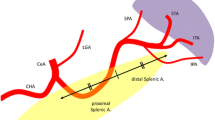Abstract
Purpose
We prospectively evaluated the validity of total and viable residual splenic volume after partial splenic embolization (PSE) with three-dimensional (3D) ultrasound (US) measurement.
Methods
Twenty patients with splenomegaly were included. All splenic volumes were measured with transabdominal US using virtual organ computer-aided analysis (VOCAL). The viable residual splenic volume after PSE was estimated by using contrast-enhanced (CE) US with VOCAL. The agreement of the measurements from VOCAL and computed tomography (CT) was confirmed using interclass correlation coefficients (ICCs) and Bland–Altman plots.
Results
Mean volume was 503 ± 250 ml for total spleen and 209 ± 108 ml for viable residual volume. Regarding total volume, there was a high correlation and agreement (ICCs = 0.90) between 3D US and CT volumetry. Regarding viable residual volume, although there was a moderate correlation between 3D CEUS and CT volumetry, mean ICCs of 0.617 indicated poor agreement. With Bland–Altman plots, a narrow 95 % limit of agreement was observed among patients with a total volume under 1000 ml.
Conclusion
The total splenic volume could be accurately estimated with 3D US. However, estimation of viable residual splenic volume should be limited in cases with total splenic volume under 1000 ml.




Similar content being viewed by others
References
Maddison FE. Embolic therapy of hypersplenism. Invest Radiol. 1973;8:280–1.
Yoshida H, Mamada Y, Taniai N, et al. Partial splenic embolization. Hepatol Res. 2008;38:225–33.
Hayashi H, Beppu T, Okabe K, et al. Therapeutic factor considered according to the preoperative splenic volume for a prolonged increase in platelet count after partial splenic embolization for liver cirrhosis. J Gastroenterol. 2010;45:554–9.
Hayashi H, Beppu T, Okabe K, et al. Risk factors for complications after partial splenic embolization for liver cirrhosis. Br J Surg. 2008;95:744–50.
Schlesinger AE, Edgar KA, Boxer LA. Volume of the spleen in children as measured on CT scans: normal standards as a function of body weight. AJR Am J Roentgenol. 1993;160:1107–9.
Breiman RS, Beck JW, Korobkin M, et al. Volume determinations using computed tomography. AJR Am J Roentgenol. 1982;138:329–33.
Lamb PM, Lund A, Kanagasabay RR, et al. Spleen size: how well do linear ultrasound measurements correlate with three-dimensional CT volume assessments? Br J Radiol. 2002;75:573–7.
Hidaka H, Nakazawa T, Wang G, et al. Reliability and validity of splenic volume measurement by 3-D ultrasound. Hepatol Res. 2010;40:979–88.
Hidaka H, Kokubu S, Nakazawa T, et al. Therapeutic benefits of partial splenic embolization for thrombocytopenia in hepatocellular carcinoma patients treated with radiofrequency ablation. Hepatol Res. 2009;39:772–8.
GE (General Electric) Healthcare LOGIQ 7 Ultrasound Transducer manual. www.vetnovations.com/images/l9_l7_transducer_guide.pdf.
Moriyasu F, Itoh K. Efficacy of perflubutane microbubble-enhanced ultrasound in the characterization and detection of focal liver lesions: phase 3 multicenter clinical trial. AJR Am J Roentgenol. 2009;193:86–95.
Kim SH, Lee JM, Lee JY, et al. Contrast-enhanced sonography of intrapancreatic accessory spleen in six patients. AJR Am J Roentgenol. 2007;188:422–8.
Hripcsak G, Heitjan DF. Measuring agreement in medical informatics reliability studies. J Biomed Inform. 2002;35:99–110.
Bland JM, Altman DG. Statistical methods for assessing agreement between two methods of clinical measurement. Lancet. 1986;1:307–10.
McGraw KO, Wong SP. Forming inferences about some intraclass correlation coefficients. Psychol Methods. 1996;1:30–46.
Shimada T, Maruyama H, Sekimoto T, et al. Heterogeneous staining in the liver parenchyma after the injection of perflubutane microbubble contrast agent. Ultrasound Med Biol. 2012;38:1317–23.
Ota T, Ono S. Intrapancreatic accessory spleen: diagnosis using contrast enhanced ultrasound. Br J Radiol. 2004;77:148–9.
Makino Y, Imai Y, Fukuda K, et al. Sonazoid-enhanced ultrasonography for the diagnosis of an intrapancreatic accessory spleen: a case report. J Clin Ultrasound. 2011;39:344–7.
Acknowledgments
We thank the radiologists at Kitasato University East Hospital for their technical assistance. We also thank Robert E. Brandt, Founder, CEO, and CME, of MedEd Japan, for editing the manuscript.
Conflict of interest
The authors declare no conflicts of interest.
Author information
Authors and Affiliations
Corresponding author
About this article
Cite this article
Hidaka, H., Wang, G., Nakazawa, T. et al. Total and viable residual splenic volume measurement after partial splenic embolization by three-dimensional ultrasound. J Med Ultrasonics 40, 417–424 (2013). https://doi.org/10.1007/s10396-013-0443-6
Received:
Accepted:
Published:
Issue Date:
DOI: https://doi.org/10.1007/s10396-013-0443-6




